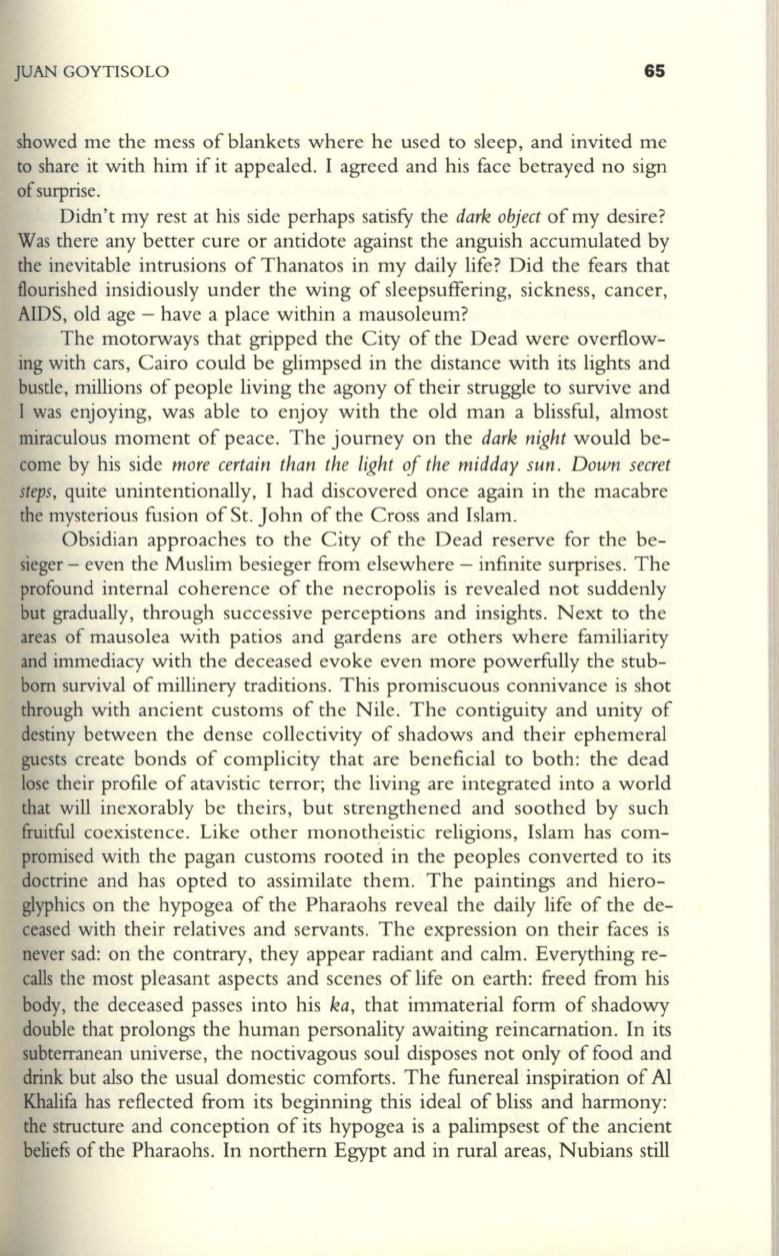
JUAN GOYTISOLO
6S
showed me the mess of blankets where he used to sleep, and invited me
to share it with him if it appealed. I agreed and his face betrayed no sign
ofsurprise.
Didn't my rest at his side perhaps satisfy the
dark object
of my desire?
Was there any better cure or antidote against the anguish accumulated by
the inevitable intrusions of Thanatos in my daily life? Did the fears that
flourished insidiously under the wing of sleepsuffering, sickness, cancer,
AIDS, old age - have a place within a mausoleum?
The motorways that gripped the City of the Dead were overflow–
ing with cars, Cairo could be glimpsed in the distance with its lights and
bustle, millions of people living the agony of their struggle to survive and
I was enjoying, was able to enjoy with the old man a blissful, almost
miraculous moment of peace. The journey on the
dark night
would be–
come by his side
more certain than the light oj the midday sun. Down secret
steps,
quite unintentionally, I had discovered once again in the macabre
the mysterious fusion of St. John of the Cross and Islam.
Obsidian approaches to the City of the Dead reserve for the be–
sieger - even the Muslim besieger from elsewhere - infinite surprises. The
profound internal coherence of the necropolis is revealed not suddenly
but gradually, through successive perceptions and insights. Next to the
areas of mausolea with patios and gardens are others where familiarity
and immediacy with the deceased evoke even more powerfully the stub–
born
survival of millinery traditions. This promiscuous connivance is shot
through with ancient customs of the Nile. The contiguity and unity of
destiny between the dense collectivity of shadows and their ephemeral
guests create bonds of complicity that are beneficial to both: the dead
lose their profile of atavistic terror; the living are integrated into a world
that will inexorably be theirs, but strengthened and soothed by such
fruitful coexistence. Like other monoth.eistic religions, Islam has com–
promised with the pagan customs rooted in the peoples converted to its
doctrine and has opted to assimilate them. The paintings and hiero–
glyphics on the hypogea of the Pharaohs reveal the daily life of the de–
ceased with their relatives and servants. The expression on their faces is
never sad: on the contrary, they appear radiant and calm. Everything re–
calIs the most pleasant aspects and scenes of life on earth: freed from his
body, the deceased passes into his
ka ,
that immaterial form of shadowy
double that prolongs the human personality awaiting reincarnation. In its
subterranean universe, the noctivagous soul disposes not only of food and
drink
but also the usual domestic comforts. The funereal inspiration of AI
Khalifa has reflected from its beginning this ideal of bliss and harmony:
the structure and conception of its hypogea is a palimpsest of the ancient
beliefs of the Pharaohs. In northern Egypt and in rural areas, Nubians still


